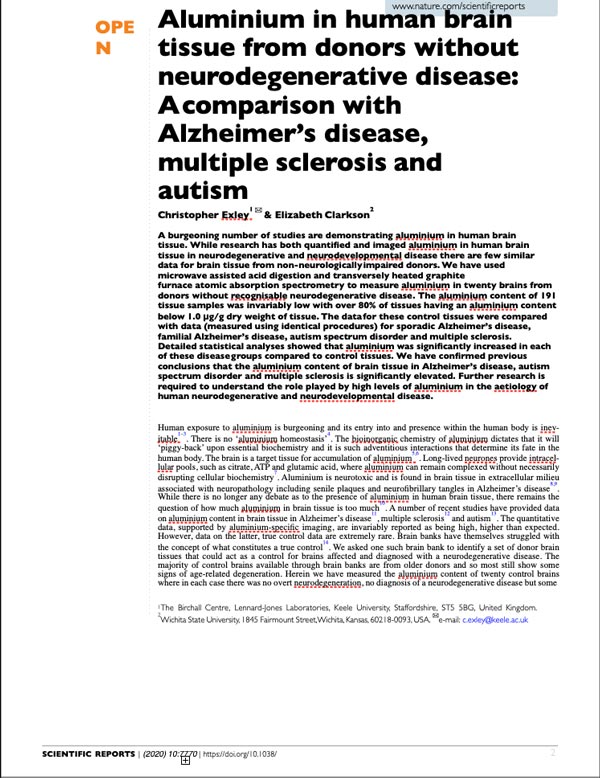Watch Professor Christopher Exley Explain in Simple Terms
How Aluminum Gets into the Brain and
Causes Autism and Alzheimer’s Disease
Here Professor Exley Answers Questions
Professor Chris Exley- Professor in Bioinorganic Chemistry – Aluminium and Silicon Research Group The Birchall Centre, Lennard-Jones Laboratories-Keele University, Staffordshire, ST5 5BG, UK

In pictures A and B You can see Aluminum is a bright yellow when the concentration is high and in the other areas where it is lower it gives an orange florescence.
When aluminum enters the body, from external uses (not from food) white blood cells known as Macrophages rush to the point of entry to collect it and take it to the brain. The brain becomes the quarantine area for aluminum that is loose in the body.
Exley: “Aluminum loaded up in the cells in the body and moving into the brain taking their aluminum with them”
“ If there was no aluminum in the brain, there would be no Alzheimer’s”
Professor Christopher Exley
Drink your beverages from bottles not aluminum cans.
It will save your brain and your colon.
The Emperor is Naked: No aluminium, no Alzheimer’s disease. This is the, perhaps unexpected, conclusion of a new open access paper published in Journal of Alzheimer’s Disease Reports. Putting the headline in context what is actually being suggested is that brain content of aluminium is a catalyst for Alzheimer’s disease. In the absence of pathologically significant deposits of aluminium in brain tissue there would not be any (acute) Alzheimer’s disease within a normal lifespan of say 100 years. Support for this conclusion has been building over the last decade or so and has now been put on an unequivocally firm footing by recent research demonstrating the exceedingly high content of aluminium in brain tissue in individuals who died with a diagnosis of familial Alzheimer’s disease.
Individuals with familial Alzheimer’s disease have specific genetic predispositions to Alzheimer’s developing earlier in life, perhaps as early as the fourth or fifth decade of life. All of these genetic predispositions are associated with how the body metabolises the amyloid precursor protein (APP) and yet there is no unequivocal explanation of how APP and its metabolic products, such as amyloid β cause Alzheimer’s disease. The contention in the new research is that these genetic mutations in the metabolism and processing of APP concomitantly act as predispositions to the retention of aluminium in brain tissue. Increased absorption of aluminium across the gut, as is seen in late-onset Alzheimer’s disease and in Down’s syndrome, could contribute to increased retention of aluminium in brain tissue. However, while we do not know the mechanism behind this increased retention what we do know is that when brain aluminium content is increased, and not because of specific genetic mutations but due to environmental or occupational exposure to aluminium, then an earlier form of late-onset or sporadic Alzheimer’s disease will occur.
There are clearly many potential contributory factors in the aetiology of Alzheimer’s disease but what is now being suggested is that without concomitant pathologically-significant deposits of aluminium there would not be any Alzheimer’s disease.
It is intriguing that the first reported case of Alzheimer’s disease, which occurred less than 20 years following the advent of the aluminium age, was in a woman in her fifties and we now know that she was also the first documented case of familial Alzheimer’s disease. We would expect her brain to be characterised by pathologically-significant deposits of aluminium! https://www.hippocraticpost.com/author/professor-chris-exley
A comparison with Alzheimer’s, Autism and Multiple Sclerosis.
The aluminium content of 191 tissue samples was invariably low with over 80% of tissues having an aluminium content below 1.0 μg/g dry weight of tissue. The data for these control tissues were compared with data (measured using identical procedures) for sporadic Alzheimer’s disease, familial Alzheimer’s disease, autism spectrum disorder and multiple sclerosis. Detailed statistical analyses showed that aluminium was significantly increased in each of these disease groups compared to control tissues. We have confirmed previous conclusions that the aluminium content of brain tissue in Alzheimer’s disease, autism spectrum disorder and multiple sclerosis is significantly elevated.


